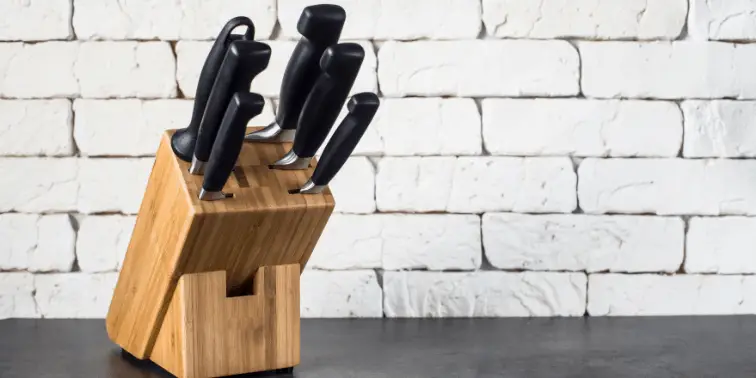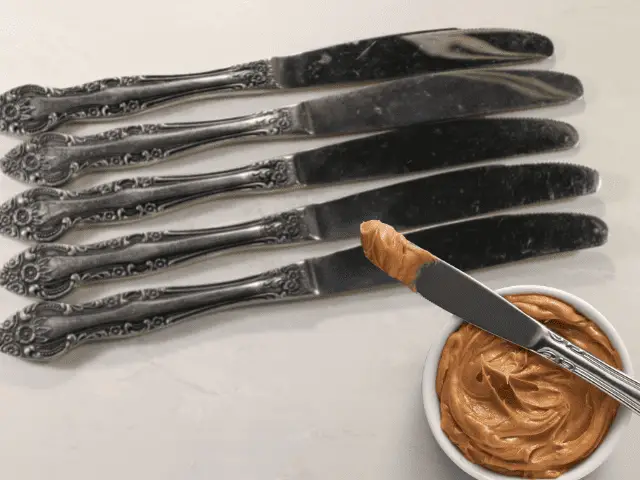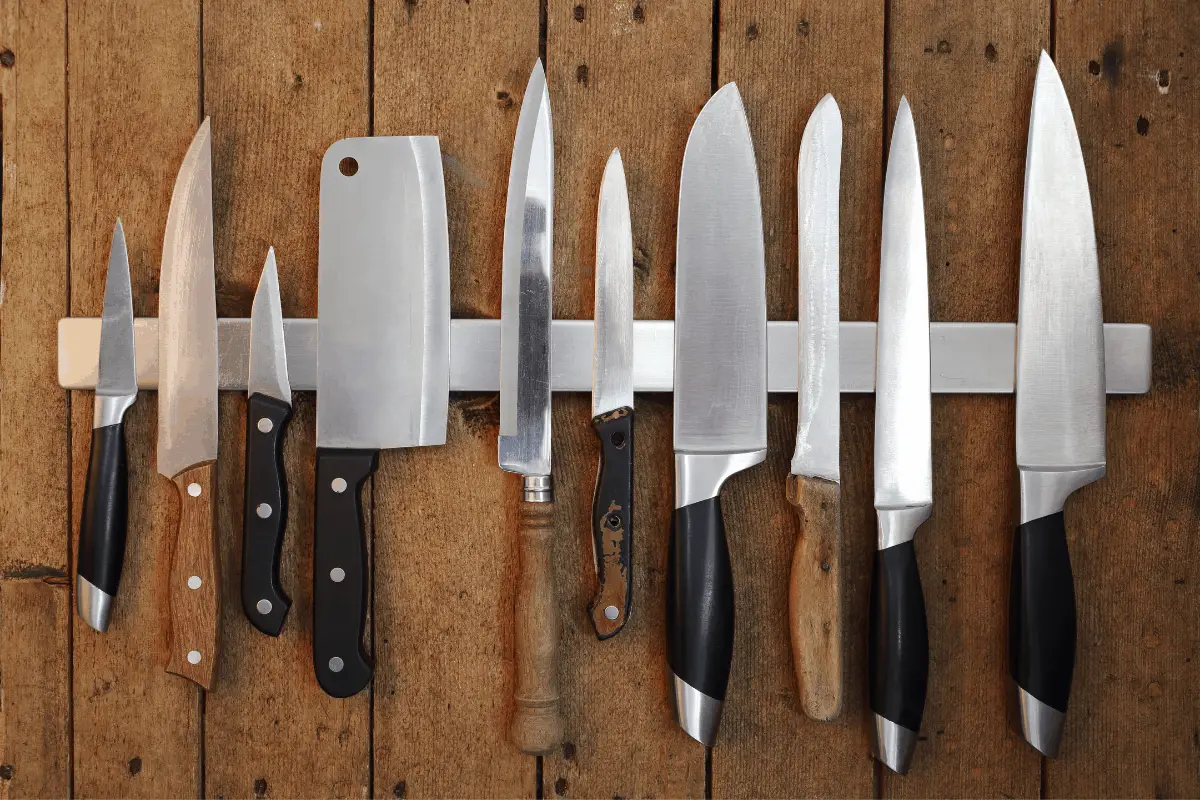Most households have various knives in the kitchen for preparing, serving, and eating food. However, knives have a way of accumulating over time. Those living in a first apartment will often have one or two inexpensive knives from the supermarket or discount store, while larger, more “mature” households tend to have matched sets they store in one or more knife blocks.
It’s not hard to tell if there’s a home chef present. Just look at the quality and diversity of the collection. Knife block “starter” sets make great graduation or wedding gifts since they can expand over time. A small set with a chef‘s knife, a bread knife, and a paring knife can quickly double when adding, for instance, Japanese santoku counterparts.
And let’s not forget that handy filleting knife you just had to have!
These collections expand in size and scope as time passes, and before you know it, there are knives from all over the world or designed for some highly specialized tasks. Of course, true foodies like me cherish their kitchen knife collections. But, what happens when people like us need to pack our knives for moving? How can we do it successfully? Let’s talk about it!
Table of Contents
Packing a Knife Block

A knife block is a solid, heavy piece of wood with slots to hold a few dozen kitchen knives. Many also have spaces for kitchen shears and a sharpener. A knife block sits on the counter and keeps your knives clean and ready when needed. When it’s anywhere other than a countertop or kitchen table, though, and isn’t holding any knives, it’s little more than a block of wood.
Packing a Knife Block Including Knives
Many recommendations advocate using the knife block itself to protect kitchen knives—and make it safer for those handling them. Doing this properly means using plenty of strong tape to keep the blades in their slots and anchor the exterior wrapping.
Make sure to cover the knives and block first with either packing paper or bubble wrap before taping the knives into the block. Not just to protect the knives, but if you don’t you’re going to spend a ton of time trying to wash the ‘sticky’ off of your knives. No fun.
Perhaps it’s the functional merging of knife block and knives we see in so many homes that makes them seem inseparable. But is there a good reason to pack the knife block and its sharp contents as a unit? As we see it, the jury is still out on this. We believe that wrapping individual or groups of knives is neither more nor less dangerous than securing them to a knife block.
And we lean just a bit toward removing the knives from the block and packing them separately.
Packing a Knife Block Without Knives
So, what if you choose to pack the knives and knife blocks separately? Well, the knife block on its own is virtually indestructible. Still, it can be heavy, and you should pack them in a box with lighter items, such as clothing, placemats, towels, or anything that will keep the block from bumping around inside the box.
Now, let’s find out with to do with stray knives or those you removed from a knife block.
Packing Knives Without a Knife Block
Yes, there are pros and cons to packing fully loaded knife blocks. It can be risky either way. That’s why people who use knife blocks often prefer to pack their kitchen knives separately, whether individually (as with a large chef’s knife) or in groups (as with a set of steak knives). To us, it seems easier to spot the sharp edges of blades when they’re in their own packaging.

Wrapping Kitchen Knives for Moving
We recommend the following steps for wrapping kitchen knives for moving:
- Begin by separating your kitchen knives according to shape and size. That way, no sharp edges will jut out.
- Wrap each knife in paper or encase it in folded cardboard, being sure to tape it so the knife won’t slip out.
- Bundle them together in a kitchen towel or other soft cloth once you have a small group of knives (4-5). It would be best to pack larger knives like meat cleavers or chef’s knives separately.
- Wrap the bundle in paper and label it “knives.”
- Be sure to pack around the knives with plenty of shock-absorbing material, like bubble wrap, rags, crumpled paper, etc. As an extreme precaution, consider using expandable packing foam—which creates a protective mold around the packed objects.
- Once the box is full, label the outside so it’s clear that what’s inside could be dangerous. Then tape the box closed on all sides.
You can make this entire process really simple by splurging on a Chef’s Knife Roll Bag. They’re not that expensive and you get to feel like one of the Chefs from Top Chef (one of our all-time favorite shows) when you pack away your knives.
Some households use magnetic knife racks (like in the featured image at the top of this article) instead of butcher blocks or other knife holders. Do not even consider packing knives while they are still attached to the magnet on the rack. As we recommend with the knife block, it’s best to separate the knives from their holder before packing either.
Kitchen Knives Are Sharp!
We know this is obvious. Even so, people sometimes forget to take all necessary precautions with their kitchen knives when in a rush to move. When packing knives, be sure to consider everyone who will handle the box containing the knives—block or no block. What if a sharp knife slips out from the block or punctures the wrapping paper or cardboard?
In other words, what if a professional mover, unknowing family member, or other helper opens an unlabeled or poorly labeled moving box, only to be injured while removing the contents.
And don’t forget to label the box with warnings like “Caution, knives” or “Attention: sharp edges.” Also, with knives wrapped individually, you should draw arrows on the packing paper pointing to the sharp edges.
Don’t Forget the Flatware

Dinner knives, butter knives, steak knives, etc., are standard parts of table settings. Sometimes, these can be pretty sharp—not quite to the extent of larger kitchen knives that were designed to cut through meat and other tough foods.
But steak knives especially, and some dinner knives, are sharp enough to cause serious wounds. Even a fork can do some harm.
We recommend packing all flatware and serving utensils in the same box or boxes. As with kitchen knives, these pieces should be bundled, like with like, wrapped, and labeled. Bundled flatware and serving utensils can travel in a drawer separator if you have one. That should travel in another box so that everything stays together and there are no errant sharp edges.
We don’t have enough room here to discuss the many other knives people have in their homes—including pocket knives, mat knives, paper knives, carving knives, decorative knives, putty knives, the occasional scalpel, and even knives used as weapons.
So we’ll simply offer a quick reminder to handle blades of all types with extreme care.
Wrap it Up Safely
Safety comes first when handling knives in any capacity. Lucky for us, all sorts of methods and materials are available when packing kitchen knives and knife blocks for moving (or shipping). Unfortunately, not only can unsecured knives hurt those handling them, but they can also damage any objects or materials sharing the moving box, including the box itself.
And, of course, if you’re a dedicated home chef or professionally trained chef, you’re well aware of the expense and long-term care you’ve put into your kitchen knife collection. So pack your valuable knives with consideration for the journey. No one will suffer harm, and your kitchen knives will serve you well in your new home for years to come.


